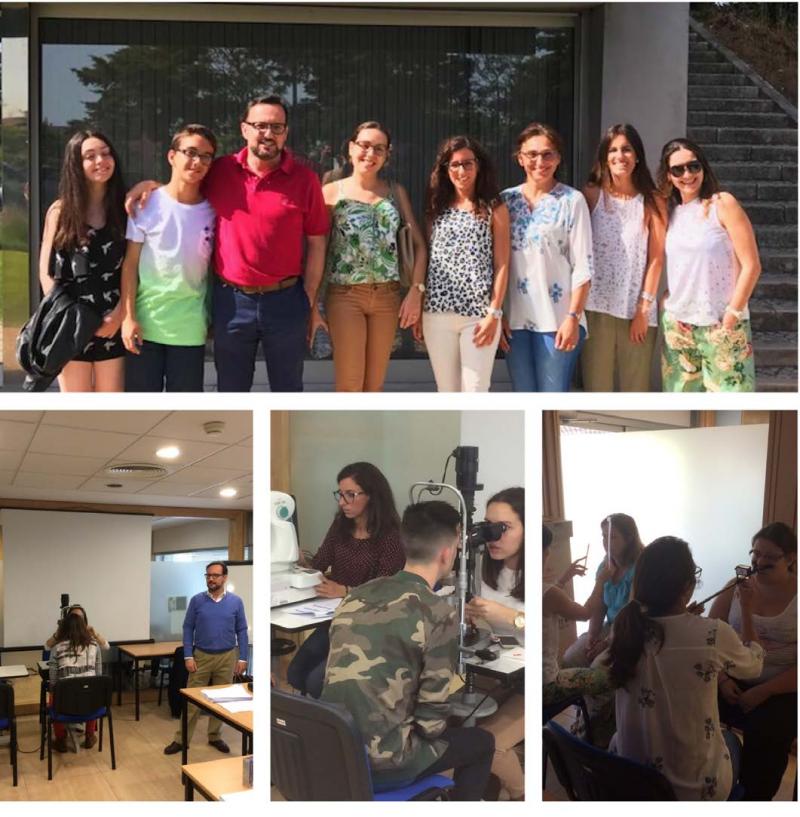4.2 Digital Asthenopia- Portuguese Ergophthalmology Group Survey – Konecta Study
Introduction
With increasing use of numerous electronic devices - computers, tablets, smartphones or video games- the population is subject to a greater effort of near vision, with increased accommodation and convergence, as well as greater visual attention with consequent decreased blinking and dry eye complaints.
When this effort is intense and/or maintained (periods longer than 2 hours), adaptation mechanisms fail, with exhaustion of the ocular muscles (intrinsic and extrinsic) and subsequent visual fatigue (asthenopia), leading to an incapacity to accomplish the tasks that were intended - Digital Asthenopia.
This study intends to evaluate the prevalence of signs and symptoms of dry eye and ocular fatigue - digital asthenopia - in a population of individuals who use the computer daily to perform all their tasks - Outsourcing service company Konecta® employees .
It is also intended to assess whether the increase in the number of hours of computer use is associated with an equal increase in ocular surface changes, as well as whether the implementation of behavioral measures and administration of teardrops (sodium hyaluronate 0.15% - Hyabak® Théa Laboratories) may attenuate the complaints.
Material and methods
The survey included Konecta® employees who use the computer throughout all their work hours to perform their Teleperformance tasks. A total of 77 individuals (154 eyes) were evaluated on 2 separate days with a 1-month interval. The two evaluations were carried out in a similar way, by the same researchers, and by the same order of observation.
Subjective assessment - All subjects were asked to complete two questionnaires:
1. Ocular Surface Disease Index (OSDI) Questionnaire, which evaluates complaints related to ocular surface disturbances secondary to dry eye (0-100% scale);
2. and a second questionnaire that addresses eye fatigue– Portuguese Group of Ergophthalmology (PGE) Questionnaire (score of 0-16).
The objective assessment was performed in both eyes, consisting of:
1. Schirmer test without anesthetic - Normal test if> 15 mm in <5 minutes and abnormal if <15 mm in> 5 minutes;
2. DR-1a Dry Eye Monitor by KOWA® - Objective evaluation of lacrimal film with this apparatus allows observation of the tear film through an optical interference phenomenon and classifies the tear break test in a non-invasive manner (NI BUT) - classification of 1 to 4, where 1 means existence of good tear film, and 4 means bad tear film;
3. Biomicroscopy with hyperemia evaluation (present or absent), lacrimal break up time (BUT) (normal if> 10 seconds, altered if <10 seconds), presence of keratitis and lesions in the conjunctiva (evaluated according to the Oxford scale, from 0 to 5, in that 0 is unchanged and 5 with many changes);
4. Accommodation and convergence – near accommodation point, measured with RAF ruler, normal or altered for age according to ruler scale, near convergence point measured in cm with RAF ruler, normal if <10cm, altered if > 10cm.
After the first evaluation, the subjects were divided into 2 groups: group A (first 34 observations, included individuals with less than 2 hours of computer working) and group B (remaining 43 observations, corresponding to the rest of population study, and that were the ones with more than 2 hours of computer working).
To the latter were explained some environmental measures to reduce digital asthenopia complaints (regulation of environment humidity, lighting, screen positioning, pauses during computer activity- rule 20/20/20) and therapeutic measures for dry eye reduction with the recommendation of the use of artificial tears (Hyabak®) whenever they had dry eye symptoms.
Results
A total of 77 individuals (154 eyes) were observed, with a median age of 34 years and 59 were females (77%). More than half (58%) of individuals wore glasses and 12% wore monthly contact lenses.
In the first evaluation, the median OSDI score is 29 and the ocular fatigue score is 7. Only 8% of subjects had alterations in the Schirmer test, 25% had alterations in the BUT, 18% had hyperemia.
Forty-four percent had accommodation disturbances and 12% had convergence disabilities.
There was a statistically significant difference in the majority of the parameters evaluated in the afternoon (group B) comparing to the morning period (group A) - tear film (p=0.032), hyperemia (p<0.001), BUT (p<0.001), keratitis (p<0.001), conjunctival lesion (p=0.002) and accommodation point (p<0.001).
There were no statistically significant differences in the Schirmer test (p=0.303), near convergence point (p=0.440) and ocular fatigue (p=0.567).
In the second evaluation – one month later - there were no statistically significant differences in any of the parameters analyzed in group A – without behavioral intervention.
In group B- the group that was given the recommendations described above- most clinical parameters improved at the end of that period - Schirmer test (p=0.005), lacrimal film (p=0.022), keratitis (p<0.001), conjunctival lesion (p=0.005), near convergence point (p=0.001) and fatigue score (p<0.001).
However, there were no statistically significant changes in near accommodation point (p=0.106), hyperemia (p=0.265) or OSDI score (p=0.492).
Discussion and Conclusion
From the assessment, we made on the first day, and when comparing the objective evaluation between the morning group versus the afternoon group, we found more manifestations of dry eye and ocular fatigue in the latter.
This probably reflects the longer time of screen exposure. The longer and more frequent one uses digital devices, the more one is affected by ocular or physical symptoms.
The reduced clinical complaints and the objective results after 1 month, in group B, in which we intervened (environmental measures, pauses and use of lubricants), demonstrates their importance in the prevention and treatment of this syndrome.
We concluded that the longer we use electronic devices (more than 2 hours) the higher are the complaints and ocular surface changes rates.
Environmental and ocular strategies can attenuate or even eliminate the discomfort caused by this syndrome, and increase professional performances and quality of life.
Acknowledgements:
To Konecta® company, in particular to its general director in Portugal Dr. Maldonado, for the availability and kindness in letting us perform this study at its Restelo’s facilities, but above all for the courage to evaluate its employees. As he always told us 'it's important to see if there's any problem so we can improve our working conditions' sic. Praiseworthy and very constructive attitude.
To Théa Laboratoires (Portugal), and in particular to its director, João Caldas, for all his enthusiasm, effort and commitment to this project and to make it go forward despite some setbacks.
And to J. Cotta® Company for providing us, at no cost, all the ophthalmologic equipment we needed it, including the KOWA® Dry Eye Monitor DR-1a Dry Eye Monitor.


